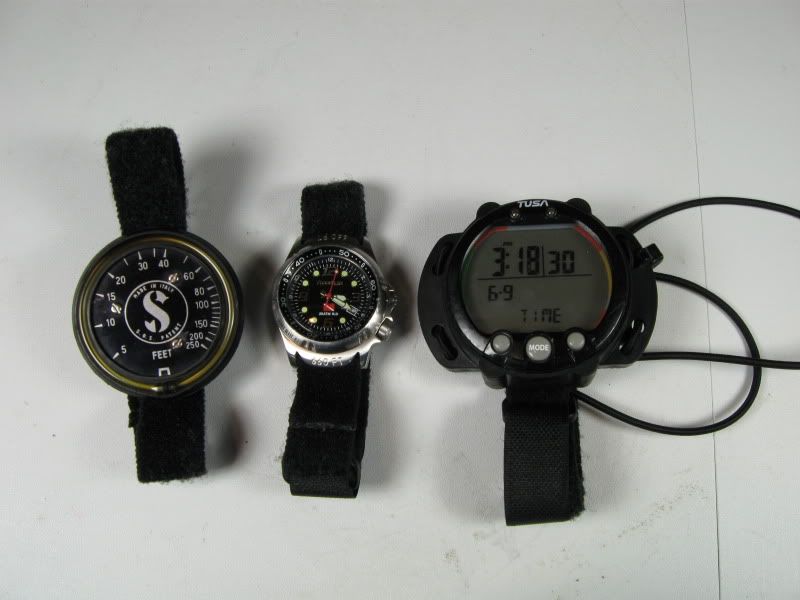Here is a picture of the decompression instruments I used for the dive last Friday.
On the right is my TUSA IQ-700 computer, which is the exact same computer as the Dive Rite Nitek Duo, the Apeks Quantum, the Zeagle N2ition, and the same internals as the Cressi Archimede. I did use it in the computer mode, but I followed the V-Planner schedule shown above.
The watch on the center is just a basic battery driven dive watch. It is nothing special, but it keeps good enough time and it can go deeper that I will care to go.
On the left is a capillary depth gauge. For anyone that is not familiar with one, there is no needle, no moving parts. The water just compresses the trapped air. It is very easy to read and extremely precise from 30 ft and shallower. As long as the scale doest rotate, it will never go out of calibration either.
We have always known that the capillary depth gauge is an ideal gauge for deco diving. It is interesting that it is still recommended in my TDI deco procedures book, but I have the impression that it is not as popular as it should be with tech divers.
They still make capillary depth gauges (Trident sells one), but the ones I have seen look cheaply made. The display card on the Trident looks like a photo copied piece of paper that someone drew in the back room.
It was good to see that my nice expensive computer can measure depth in shallow water as precisely as the capillary gauge. They were both reading exactly the same depth.
In deep water the capillary gauge is very hard to read accurately.
It is nice to see a simple instrument like this perform so well for almost 40 years.
I do need to replace the little clear hose. I need to send a PM to Herman.

On the right is my TUSA IQ-700 computer, which is the exact same computer as the Dive Rite Nitek Duo, the Apeks Quantum, the Zeagle N2ition, and the same internals as the Cressi Archimede. I did use it in the computer mode, but I followed the V-Planner schedule shown above.
The watch on the center is just a basic battery driven dive watch. It is nothing special, but it keeps good enough time and it can go deeper that I will care to go.
On the left is a capillary depth gauge. For anyone that is not familiar with one, there is no needle, no moving parts. The water just compresses the trapped air. It is very easy to read and extremely precise from 30 ft and shallower. As long as the scale doest rotate, it will never go out of calibration either.
We have always known that the capillary depth gauge is an ideal gauge for deco diving. It is interesting that it is still recommended in my TDI deco procedures book, but I have the impression that it is not as popular as it should be with tech divers.
They still make capillary depth gauges (Trident sells one), but the ones I have seen look cheaply made. The display card on the Trident looks like a photo copied piece of paper that someone drew in the back room.
It was good to see that my nice expensive computer can measure depth in shallow water as precisely as the capillary gauge. They were both reading exactly the same depth.
In deep water the capillary gauge is very hard to read accurately.
It is nice to see a simple instrument like this perform so well for almost 40 years.
I do need to replace the little clear hose. I need to send a PM to Herman.





